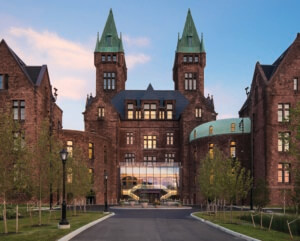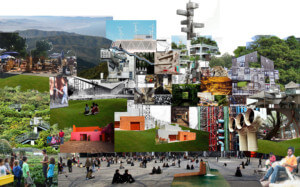With investment in American cities on the rise, mixed-use development is all the buzz, but architect Deborah Berke says we must be careful not to leave industry out of the mix. “We need to sway mixed-use back to the direction of a real mix. We’ve gone to all residential,” she said. Berke and critic Noah Biklen just finished teaching an architectural studio at Yale on boutique urban manufacturing, where students explored bringing a bourbon distillery to downtown Louisville, Kentucky.
Paired with trips to Louisville and New York to study the bourbon making process and existing urban manufacturing operations, students began the semester by studying the industrial container or wrapper as an object to inform a prototype industrial facility—from tofu to bike seat manufacturing—before moving on to the urban distillery. Each student proposal took a unique approach to urban manufacturing, challenging established notions of how industry functions, looks, and interacts with the city. “I’ve been teaching a long time and it was a very good day for presentations,” Berke said. “I loved the extraordinary diversity of the proposals. There’s no single right answer.” Students presented the relationship between manufacturing identity, brand identity, and architecture as a cohesive whole, finishing up the semester by designing a branding strategy for each distillery including a proposed bourbon bottle.
The students’ distilleries occupied a portion of a prominent block along Louisville’s Main Street, opposite a row of former bourbon warehouses nicknamed Whiskey Row, which is slated for renovation into, among other things, a boutique distillery. Ranging in size from 40,000 to 60,000 square feet, program requirements included distillation components, storage “rackhouses,” bottling operations, loading areas, and a public component including a lobby. Among the issues explored by the students was whether all components of the manufacturing process should be included in an urban setting and how much the public should be invited into the new facility.
Their final presentations in late April wowed the jury, which consisted of Patrick Bellew, Andy Bow, Joe Day, Eric Doninger, Karen Fairbanks, Martin Finio, Ann Marie Gardner, Alan Plattus, Annabelle Selldorf, and Henry Urbach. “I vetted everybody as a bourbon drinker,” Berke quipped at the review. The review wrapped up with a toast—of bourbon, of course—and one last discussion of the future of urban manufacturing.
Berke said the student proposals demonstrate how boutique industries can operate in an urban environment. “Architecture and design can help citizens visualize the potential of boutique manufacturing,” Berke said. “I don’t think architects can create an industrial model. They can create an urban model.” Boutique industry emerging in cities is all about products that already have an urban market.
Daniel Dickens’ Alchemy Bourbon, situated on the site’s most prominent corner, is divided into two zones, the distillery and a series of separated storage warehouses, providing for fire protection for the highly flammable spirit as it ages. Each small “rackhouse” is positioned in a landscaped yard to provide varying climactic conditions that impact the product’s flavor profile. Dickens chose a Cor-ten classing for its appearance of strength and the rusting process of change as it reflects the aging of bourbon.
Kathryn Lenehan proposed a glass box covered with wooden louvers reclaimed from old bourbon barrels for her Oak & Char distillery that reveal the theatricality of the industrial process to the street outside. Operable windows allow natural ventilation inside the facility and a great hall through the center organizes a bar and tasting room, garden, and theater alongside industrial functions.
Margaret Hu‘s Black Diamond Bourbon Distillery positions a new semi-transparent black box alongside a repurposed historic building wrapping the multi-layered industrial processes inside. Daylight seeps through the light-transmitting fiber-cement facade, creating a sense of intrigue inside. Spaces containing various components of the distillation process are positioned to create a sense of unknown origin when walking through the space, inviting visitors to explore further.
Seema Kairam opted to focus on bourbon production, leaving the storage component in a less-centralized location to mitigate real estate costs and flammability at her River Bend Bourbon distillery. The facility is imagined as high-tech glass shed covered in metal louvers able to bridge various scales of production depending on how much bourbon is desired. Spaces are organized around shared expertise and shared equipment accessed through a system of catwalks.
Lauren Page’s Main Market seeks to exploit the site’s eroded urban form to insert a sliver of green space forming an armature that could guide future urban growth. Dispensing with the production process completely, the project operates as a public market for boutique distillers to sell their wares. The building’s form winds through the city and under Main Street with a linear park above.
Mollie Ponto chose to reuse two of the historic Whiskey Row buildings across from the original site with a new glass and steel rackhouse at one end for her Repository Row Bourbon distillery. The proposal takes advantage if the sloping site’s varying entry levels to allow separation of loading facilities from a public entrance. An educational component including a bourbon archive plays a key role in the distillery’s design, forming a central spine around which the industrial processes are organized.
Rafael Ng proposed a courtyard layout for his distillery he described as a “gastronomic temple.” Clad in a light-emitting brick-latticework in a flemish-bond pattern, the exterior facade resembled a modern take on traditional rackhouse design in rural Kentucky. Accessed from a corner, industrial processes wrap around the courtyard, which could hold public functions such as markets or dinners.
Francesco Galetto‘s Chester Prescott Distillation Tower stacks the distillery’s industrial processes to create a gravity-powered, closed-system vertical factory topped with a tasting room on its roof. Grains are elevated to the top of the tower and proceed through a distillation process wrapped around a central core, as demonstrated in the unwound section above. The tower’s facade is left open around to reveal the industrial processes happening inside and is wrapped with a bronze ribbon that reflects the chemical process of distillation.
John Lacy‘s Cabinet of Curiosities proposal focuses on bourbon making not only as industry, but as a form of art. The distillery is organized around a linear procession of sensory experiences, from the sensation of touching grain as it enters the facility from a rooftop funnel, to the smell of mash cooking in large vats, to the rattling sound of the distillation process. Organized around an industrial courtyard, the structure is shrouded in a metal mesh veil acting as a unifying element of the design.
Diana Nee proposed an “urban-industrial spectacle” along an alleyway at the block for her Alley Industries distillery. The 40-foot-wide building is clad in glass on the north facade to reveal the industrial activity inside and hovers atop the alley below to bring new life to the historic city infrastructure. The south facade incorporates permeable, plantable mesh allowing for natural ventilation and includes two rooftop spheres that capture carbon dioxide from the manufacturing process.
All images courtesy respective students. Click on a thumbnail to launch slideshow.










